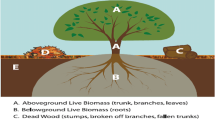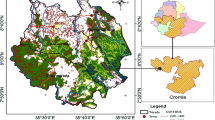Abstract
The carbon stock capacity of forest is deteriorated by anthropogenic factors, which causes for aggravation of climate change. Therefore, the study was undertaken to estimate the carbon stock capacity of Wacho forest and its implication for climate change mitigation. A systematic random sampling technique was employed to assemble the data from 20 m × 20 m of 73 sample plots. Trees and shrubs were collected from 20 m × 20 m main plots, whereas litter and soil samples were collected from each of the five 1 m × 1 m subplots situated at the four corners and one at the midpoint of the main plot. Descriptive statistics were used to find out the maximum, minimum, mean and standard deviations of carbon stock, while one-way analysis of variance was employed to test the effect of altitudinal gradient on carbon stock of the study area. The mean aboveground carbon, belowground carbon, litter carbon and soil organic carbon of Wacho forest were estimated to be 276.84, 55.37, 1.79 and 109.67 ton ha −1 respectively, and the total carbon stock capacity of Wacho forest was 443.76±64.21 ton ha−1. Altitudinal gradient had a statistically significant effect only on litter carbon stock of the study forest at α 0.05. Aboveground carbon and belowground carbon had strong correlation with normalized difference vegetation index and enhanced vegetation index (R2 = 0.82). The implication of Wacho forest for climate change mitigation was estimated to be 1,628.6 ton ha−1 CO2 equivalent. Therefore, the government should start REDD+program on the study forest.





Similar content being viewed by others
References
Oreskes N (2004) The scientific consensus on climate change. Sci 306(5702):1686–1686
Charlson RJ, Valero FP, Seinfeld JH (2005) In search of balance. Sci 308(5723):806–807
Jackson RB, Jobbágy EG, Avissar R, Roy SB, Barrett DJ, Cook CW (2005) Trading water for carbon with biological carbon sequestration. Sci 310:1944–1947
Grace J (2004) Understanding and managing the global carbon cycle. J Ecol 92(2):189–202
ITTO (International Tropical Timber Organization, 2002) Guidelines for the restoration, management and rehabilitation of degraded and secondary tropical forests (No. 13)
Silver WL, Ostertag R, Lugo AE (2000) The potential for carbon sequestration through reforestation of abandoned tropical agricultural and pasture lands. Restor Ecol 8(4):394–407
Corbera E, Estrada M, Brown K (2010) Reducing greenhouse gas emissions from deforestation and forest degradation in developing countries: revisiting the assumptions. Clim Chang 100(3–4):355–388
Gibbs HK, Brown S, Niles JO, Foley JA (2007) Monitoring and estimating tropical forest carbon stocks: making REDD a reality. Environ. Res. Lett. 2:045023. https://doi.org/10.1088/1748-9326/2/4/045023
Pan Y, Birdsey RA, Fang J, Houghton R, Kauppi PE, Kurz WA, Ciais P (2011) A large and persistent carbon sink in the world’s forests. Sci 333(6045):988–993
Bongers F, Wassie A, Sterck FJ, Bekele T, Teketay D (2006) Ecological restoration and church forests in northern Ethiopia. J Drylands 1(1):35–44
Tesfaye S, Guyassa E, Raj AJ, Birhane E, Wondim GT (2014) Land use and land cover change, and woody vegetation diversity in human driven landscape of Gilgel Tekeze Catchment, Northern Ethiopia. Int J For Res 2014:1–10. https://doi.org/10.1155/2014/614249
FDRE (Federal Democratic Republic of Ethiopia, 2012) Addis Ababa greenhouse gas emission inventory. Addis Ababa Ethiopia
Karki S, Joshi NR, Udas E, Adhikari M.D, Sherpa S, Kotru R, Ning W (2016) Assessment of forest carbon stock and carbon sequestration rates at the ICIMOD knowledge park at Godavari. ICIMOD Working Paper (2016/6)
Sahile M (2011) Estimating and mapping of carbon stocks based on remote sensing, GIS and ground survey in the Menagesha Suba State Forest (Doctoral dissertation. Thesis, Addis Ababa University, Addis Ababa), M. Sc
Feyissa A, Soromessa T, Argaw M (2013) Forest carbon stocks and variations along altitudinal gradients of Egdu Forest and Implications of managing forests for climate change mitigation. J Sci Technol Art 2(4):40–46
Girma A, Soromessa T, Bekele T (2014) Forest carbon stocks in woody plants of Mount Zequalla Monastery and it’s variation along altitudinal gradient: implication of managing forests for climate change mitigation. Sci Technol Arts Res J 3(2):132–140
Dagnachew T (2016) Carbon stock of meskele gedam forest and its contribution to climate change mitigation (doctoral dissertation. Thesis, Adis Ababa University, Addis Ababa), Msc
Ewunetie GG, Miheretu BA, Mareke GT (2021) Carbon stock potential of sekele mariam forest in North Western Ethiopia: an implication for climate change mitigation. Model Earth Syst Environ 7:351–362. https://doi.org/10.1007/s40808-020-01044-w
Gashu G, Gidey G, Deressa S, Fekansa Z, Awoke H (2020) Carbon stock variation along altitudinal gradient of wacho forest in hawa galan District kellem wollega zone Oromia Region Ethiopia
Pearson T, Walker S, Brown S (2005) Sourcebook for land use landuse change and forestry projects. Winrock international and the bio carbon fund of the world bank Arlington USA
Bekele A (1993) Useful Trees and shrubs for Ethiopia: identification propagation and management for agricultural and pastoral communities RSCU/SIDA
Chave J, Rejou Méchain M, Búrquez A, Chidumayo E, Colgan MS, Delitti WB, Henry M (2014) Improved allometric models to estimate the aboveground biomass of tropical trees. J Glob chang biol 20(10):3177–3190
Henry M, Besnard A, Asante WA, Eshun J, Adu-Bredu S, Valentini R, Saint André L (2010) Wood density, phytomass variations within and among trees, and allometric equations in a tropical rainforest of Africa. J For Ecol Manag 260(8):1375–1388
Pearson TR, Brown SL, Birdsey RA (2007) Measurement guidelines for the sequestration of forest carbon: Northern research station. Department of Agriculture, Washington, D.C., pp 6–15
MacDicken KG (1997) A guide to monitoring carbon storage in forestry and agro forestry projects in forest carbon monitoring program. winrock international Institute for agricultural development Arlington Virginia. pp 87
Walkley A, Black IA (1934) An examination of the Degtjaref method for determining soil organic matter, and a proposed modification of the chromic acid titration method. Soil Sci 37:29–38
Yohannes H, Soromessa T, Argaw M (2015) Carbon stock analysis along altitudinal gradient in gedo forest: Implications for forest management and climate change mitigation. Am j environ prot 4(5):237–244
Gedefaw M, Soromessa T, Belliethathan S (2014) Forest carbon stocks in woody plants of Tara Gedam forest: implication for climate change mitigation. J Sci Technol Arts 3(1):101–107
Linacre N (2014) Trends in voluntary and compliance REDD+ emission markets. regional climate change program REDD+ finance workshop. Antigua Guatemala
Acknowledgements
The researcher would like to thank Dambi Dollo University for its funding to conduct this research.
Author information
Authors and Affiliations
Corresponding author
Ethics declarations
Conflict of interest
The author declares that there is no conflict of interest.
Additional information
Publisher's Note
Springer Nature remains neutral with regard to jurisdictional claims in published maps and institutional affiliations.
Significance Statement This work provides quantitative data on biomass and carbon stock capacity of the study forest and its implication for climate change mitigation, which fills scientific data gaps for forest administrators and forest policymakers. Moreover, it serves as a benchmark to start reducing emission from deforestation and forest degradation (REDD +) program and carbon trading finances for Wacho forest.
Rights and permissions
About this article
Cite this article
Gashu, G. Biomass and Carbon Stock Capacity of Wacho Forest, Southwestern Ethiopia, and its Implication for Climate Change Mitigation. Proc. Natl. Acad. Sci., India, Sect. B Biol. Sci. 93, 59–69 (2023). https://doi.org/10.1007/s40011-022-01410-x
Received:
Revised:
Accepted:
Published:
Issue Date:
DOI: https://doi.org/10.1007/s40011-022-01410-x




